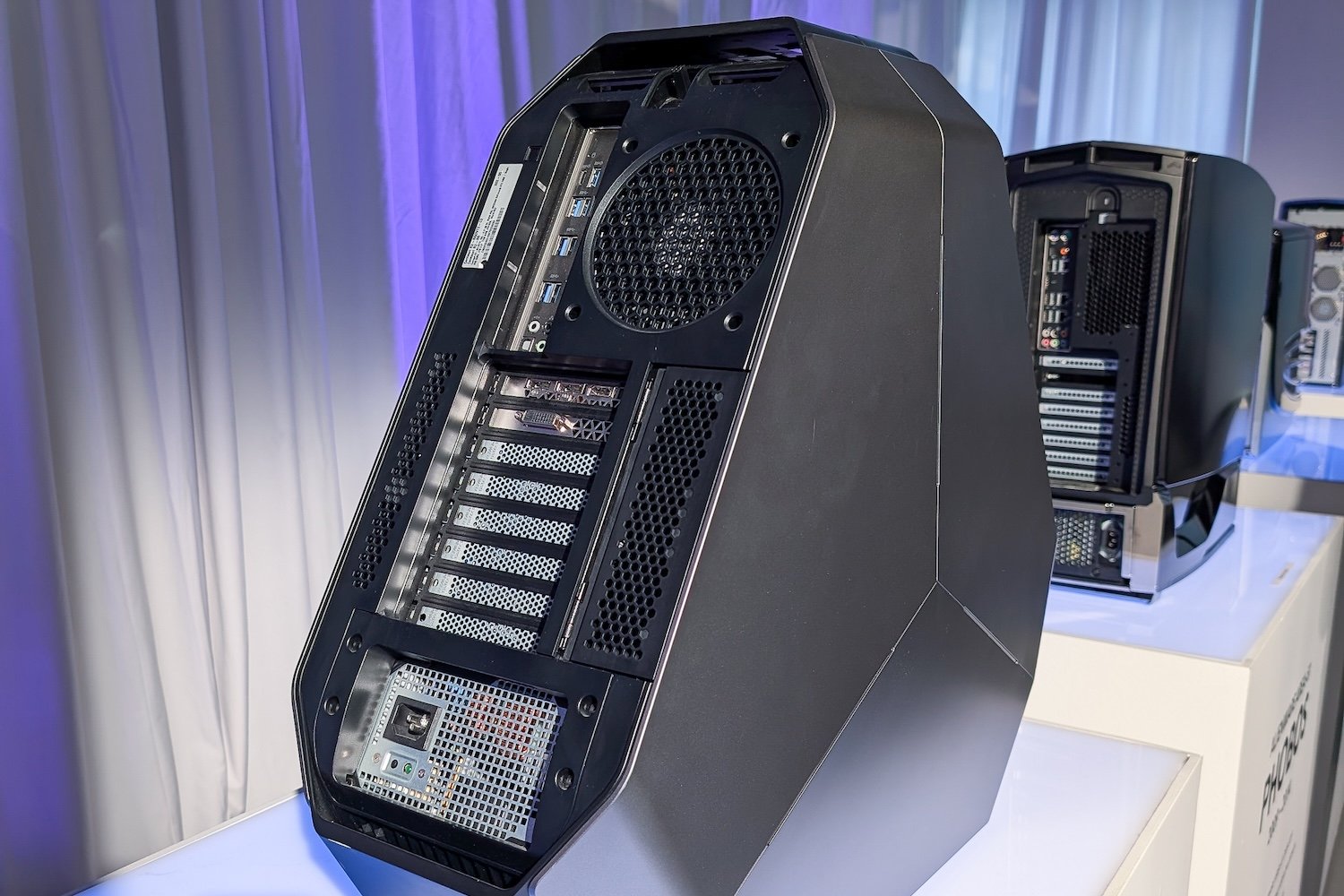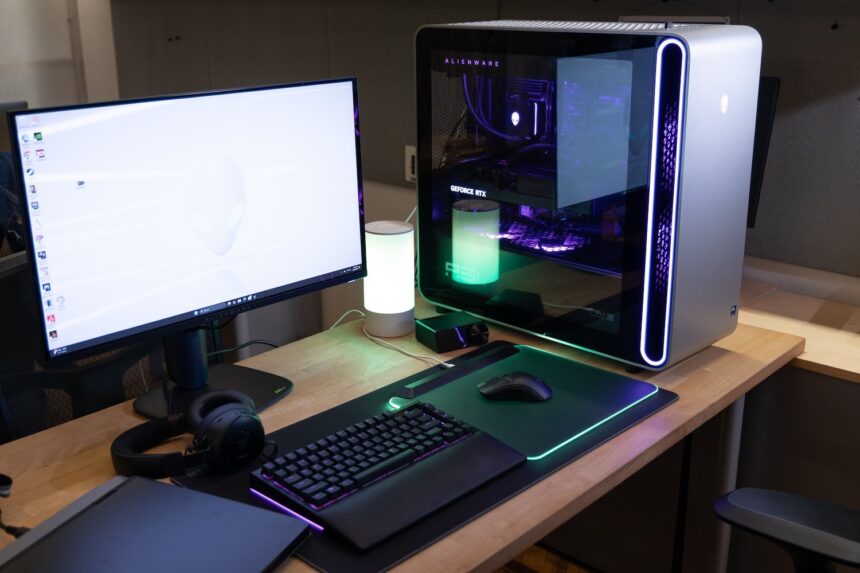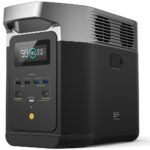There was a time, even if it was just a few years ago, when an Alienware device looked like nothing else on the market. Now, in 2025, Alienware’s Area-51 desktop is built to compete on ease and customizability, all while taking the guise of every other tower out there. There’s a benefit to that. It means this extra-large, 85L desktop tower will accommodate any and every new component you want to stick in it from now until judgement day. The downside is the Area-51 is an overly-large, samey brick of a desktop that loses the brand’s sense of self in its quest for the practical.
The Area-51 is made to be your forever case. There are half a dozen small, though still notable innovations that make it a great case for a first-time PC gamer, from the USB-loaded port selection to QR codes on every component. All this attention to detail helps future proof the Area-51 so well that I wish I could tip my hat to Alienware rather than sit here in the doldrums of melancholy.
Alienware Area-51
The Area-51 has a lot of small innovations and an interesting cooling mechanism, but it doesn’t scream “Alienware” like it should.
Pros
- Components are designed to be swapped out easily
- Positive pressure airflow actually works
- Plenty of ports for all your dongles
Cons
- Case design is boring
- Requires an additional $35 kit if you want to swap the motherboard
The main thing you notice about Alienware’s latest desktop is that its big. It’s so big, you need two people to lift it onto your desk. It’s so mundane looking, I might not want it on my desk at all. The premium build quality also comes at a premium price. The big Alienware pre-built PC starts at $3,750. Our review model, which includes the highest-end Intel Core Ultra 9 285 K and Nvidia GeForce RTX 5090, will set you back $5,500. Alienware opted for an Intel chipset, though currently the chipmaker’s highest-end desktop CPU is notably less effective for gaming scenarios, sometimes even missing benchmarks of the 14th-gen Intel chips. I would have preferred an AMD option, but that’s not available outside buying your own separate motherboard and installing it yourself. Otherwise, if it wasn’t already clear, the rest of the specs are going to absolutely blast through benchmarks thanks to that 5090 and 64 GB of DDR5 XMP 6400 MT/s memory, though you should know beforehand the board only has two RAM slots.
The Area-51 is essentially an upscaled Aurora R16 from 2024. I liked that PC, and I think that rendition feels more evocative than this rendition. The silver color doesn’t do much to accentuate the relatively few RGB accents lining the front intake mouth or internal components. The Aurora sported hexagonal shapes on the side panel, whereas the Area-51 is far more of a box with every panel line highlighted by its bright color. It’s not ugly, but it’s not something I imagine looking at next to my desk with the smug satisfaction of a PC gamer with the coolest hardware.
The best aspects of Alienware’s new design are centered around its huge body. There’s a lot of empty space inside, and that allows for a huge sliding bracket that hooks onto the end of your graphics card. Even when it’s packing a 2.5-slot Nvidia GeForce RTX 5090, there’s still an extra five inches in length you could go before hitting the front intake fan. That should leave you plenty of room to install a next-gen GPU when they inevitably arrive pricier and longer than the current generation.
And while that swappable motherboard is good news, you will also need to purchase a separate $35 conversion kit to make sure everything’s working correctly. That kit includes cables to help the new motherboard interact with the AlienFX board on the side panel. The FX board controls the RGB for the system, and it’s a testament to the design that it’s so easy to access by simply removing the right-hand side panel. Alienware hardware reps told me they opted to not include it in the box since they anticipate “only a very small percentage” of customers will want to do the upgrade immediately. The company promised it will offer the kit for “several years” after the end of the Area-51’s lifespan.
Even though the kit is a silly omission, the PC is still the most easily-upgradable Alienware unit in years. The panels are detached by unscrewing a lock, turning a dial, then hitting a button. Dell even took a page from Framework’s playbook. Every component, from the graphics card to the top fan bank, has a QR code that takes you to a dedicated page describing how to safely remove and replace the GPU, SSD, PSU, and RAM. If you have any experience with PC building, all the advice will seem rote. If you don’t know what you’re doing, the videos are relatively helpful with some basic but sane advice for handling components.
The most dramatic feature of the redesigned Area-51 is the positive pressure environment used for cooling. The CPU uses a 360mm liquid cooler unit plus fans in the front and bottom to draw in air, but the system makes use of thermodynamics to push the hot air out the rear vents. The desktop doesn’t have any exhaust fans. Instead it relies on a number of gaskets and its fitted panels to keep pressures at the necessary level inside. I would be lying if I told you I wasn’t skeptical, but it does indeed work. If you stand behind the rear vents, you can feel the hot air moving. In my tests, using Alienware’s built-in Command Center software monitoring, the PC wasn’t getting overly steamy.

Above: An older edition Area-51 Desktop compared to the 2025 Alienware Area-51.
Just to compare, I attached an old 120 mm fan to the rear exhaust to find if the PC performed any better. I didn’t experience any major difference with or without the fan after running PC Mark and spending 15 minutes apiece playing intensive games including Cyberpunk 2077 and Marvel’s Spider-Man 2. I’m sure someone might eventually find a way to soup it up with additional fans, but for now I can say is it works. Alienware claims this supplies better airflow, allowing for better temps which should also help it run better. I don’t have enough systems to offer apples to apples comparisons to check those claims. I also wouldn’t say the Area-51 system is any more silent than its contemporaries. It still will sound like a jet engine when you want to get the most out of your performance.
I don’t even need to tell you the PC absolutely blasted through benchmarks, though perhaps less dramatically than a PC like the CyberPowerPC Gamer Supreme prebuilt that sported an AMD Ryzen 9800X3D. If you want to know just how much horsepower a RTX 5090 can put out, you can find my impressions from February. Installed in the Alienware tower you get the kind of rig that will let you push even the most demanding games to full ray tracing and path tracing and still manage to get around 60 FPS at 4K, and that’s before you decide to opt for 4x framegen to push the number to over 200. The 5090 is an expensive and demanding card, so Alienware stuck a 1500W Platinum-rated ATX12VO PSU, which offers 500W more headroom than Nvidia suggests for peak performance.
Alienware pulled out all the stops for this build, all the way down to the efficient cable management. This is a primo machine made to pair with other premium hardware, like a 240 Hz QD-OLED monitor. At that point, you’re spending $6,000 on a setup, so you better like the look of it. Back in December, when Dell first showed off the new Alienware desktop, it showed us earlier models of the triangular Area 51 that looked like the landing gear for an extraterrestrial starship. The new Area-51 looks like a big desktop. I know which one I’d plug in first.
Read the full article here












